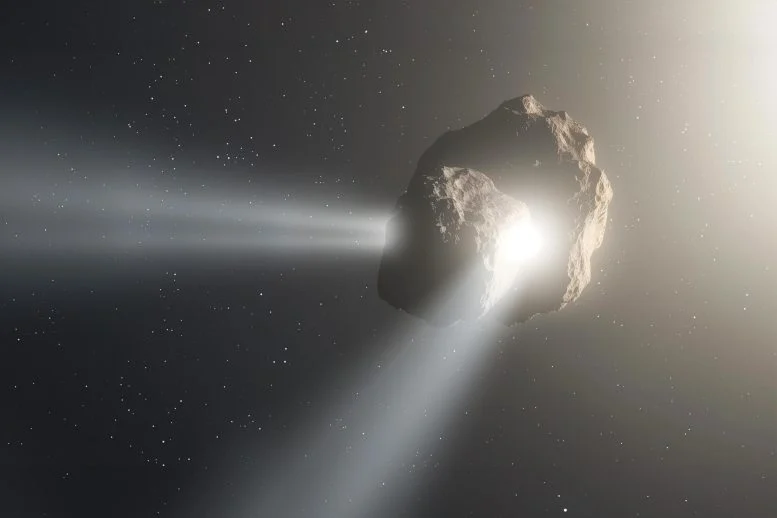"Astronomers using the James Webb Space Telescope have observed unique gas emissions from Centaur 29P, providing new insights into the chemical and physical characteristics of centaurs in our solar system. (Artist’s concept.) Credit: SciTechDaily.com" (ScitechDaily, Webb Telescope Captures Mysterious Gas Jets From Speeding Object in the Outer Solar System)
The asteroid Centaur 29P in the Kuiper Belt sends mysterious gas jets.
The JWST telescope found mysterious gas jets from asteroid Centaur 29P. That thing is one of the most interesting things in astronomy. The location of that asteroid is in the Kuiper Belt. There are two very interesting things in the asteroids that release gas jets. First, those gas jets require some outcoming energy pike that impacts asteroids.
That energy pike must come from somewhere. Another thing is that the Kuiper Belt is the most stable point in the solar system. There are no known energy sources that can cause those gas jets. That causes an interesting question: are those asteroid gas jets and the mysterious icy geyser eruptions similar sources?
The asteroid is a very lightweight object. And that means the energy impulse that causes those jets must not be very powerful to make those gas jets. It's possible that cosmic radiation particles. Or maybe antimatter particles form an energy pike that pushes gas out of stability. In fact, only small sand bites can cause massive eruptions on asteroids that are very small, and the hydrogen or helium ice hovers on that asteroid.
In some theories, even wormholes or some kind of energy pikes from primordial black holes cause the energy pike that forms those gas eruptions. We know that there is some kind of thin energy impulse that forms the icy geyser on Neptune's Triton-moon's surface. It's possible. That similar energy impulse gave the impulse that started the gas jet eruption from the asteroid Centaur 29P.
Then that causes those gas jets. The ice on that asteroid is nitrogen or some very cold gas like hydrogen ice. The temperature of those particles is just a little bit higher than the cosmic background.
If a high-energy particle hits the asteroid it raises the temperature in the ice. When the vapor starts to travel out from the asteroid, it forms friction that keeps those gas jets on, until all the gas from that icy area is gone into the form of the gas jet.
The asteroid Centaur 29P's gravity is almost zero. The ice is not very thick. That causes a situation on an asteroid, that makes this ice very unstable. Because, of low gravity and temperature that is almost zero kelvin the ice is in the condition there that gas is almost liquid. The thing that keeps that ice existent is that the solar wind is very weak. When something touches that ice it turns vapor immediately.
If that reaction brings more energy to that point than vaporization releases, the vaporization continues until the ice is gone. Vaporizing hydrogen ice can release things like dust and that brings friction. The low energy, low gravity environment doesn't require high energy impulse, that energy vaporizes ice on a small asteroid.
Sometimes it is more like some kind of aerogel or very thin structure. It's possible. There are some things like liquid helium in that ice. That means those gas eruptions can continue for a very long time. Those gas eruptions continue as long as the energy level is so low, that the hydrogen or nitrogen turns back to the ice.
https://scitechdaily.com/webb-telescope-captures-mysterious-gas-jets-from-speeding-object-in-the-outer-solar-system/





No comments:
Post a Comment
Note: Only a member of this blog may post a comment.